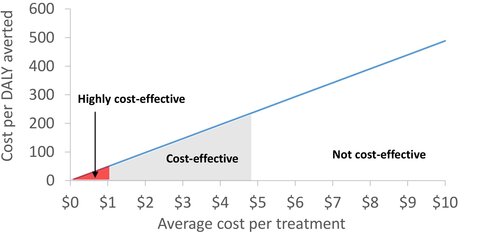Is eliminating lymphatic filariasis money well spent?

In 2000, around 120 million people were infected with lymphatic filariasis (LF). Commonly known as elephantiasis, LF impairs the lymphatic system and can lead to the abnormal enlargement of body parts, causing pain, severe disability and disfigurement (which can be associated with social stigma and exclusion). The debilitating nature of the disease reduces economic productivity of sufferers by limiting educational and employment opportunities.
The World Health Organization has targeted the elimination of LF as a public health problem by 2020. The cost to achieve this goal is an estimated $154 million every year from 2015 until 2020.
The cost-effectiveness of this investment is the subject a new analysis undertaken by a team of researchers drawn from across academia, public health and the pharmaceutical industry.
To eliminate LF as a public health problem by 2020, the WHO established the Global Programme to Eliminate Lymphatic Filariasis (GPELF) which pursued a programme of preventive chemotherapy and corrective surgery called hydrocelectomy. Between 2000 and 2014, GPELF has delivered more than 5.6 billion chemotherapy treatments to over 763 million people. Using data collected over this period, researchers were able to predict the cost-effectiveness of the GPELF approach.
The analysis looked at both the total cost of providing the treatments and health and economic benefits experienced by those treated between 2000-2014. The researchers also developed a model to investigate the number of disability-adjusted life years (DALYs) averted hydrocelectomy, and identified the cost threshold under which it would be considered cost-effective.
Analysis projected that 36 million chronic cases will be averted as a result of the first 15 years of the GPELF. This corresponds to 175 million DALYs being averted over the full lifetime of those who have received treatment through the GPELF.
The findings show that both preventive chemotherapy and hydrocele surgeries provided under the GPELF are incredibly cost-effective and offer a very good investment in public health.
The estimated economic impact
It is estimated that, as a result of the first 15 years of the GPELF, 46 million individuals will experience economic benefits due to prevented clinical disease. Individuals treated through the GPELF are estimated to save a combined total of US$96.9 billion (an average of US$2,095 per person) over their lifetime, income that would have otherwise been lost due to inability to work and medical expenses. This is equivalent to the income earned from working 33.3 days (or 11% of their average annual income).
In addition to the economic benefits to individuals, it is projected US$3.5 billion in health system costs will be saved in endemic areas. Such savings are critical for health systems in resource-poor settings.
The total economic impact (for both individuals and health systems) is estimated to be US$100.5 billion.
| Costs type | Cost per Daly averted |
| Financial Costs | $ 24 (12-39) |
| Economic costs – excluding the donated drugs value | $ 29 (14-48) |
| Economic costs – including the donated drugs value | $ 64 (49-83) |
Download the research
Turner HC, Bettis AA, et al. Investment Success in Public Health: An Analysis of the Cost-Effectiveness and Cost-Benefit of the Global Programme to Eliminate Lymphatic Filariasis. Clinical Infectious Diseases, 10 December 2016 Vol.64 (6) 728-735
Hugo C Turner, Alison A Bettis, et al. The health and economic benefits of the global programme to eliminate lymphatic filariasis (2000–2014), Infectious Diseases of Poverty